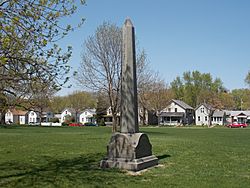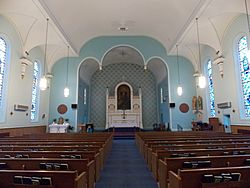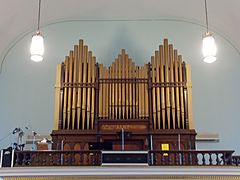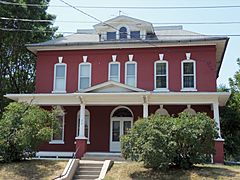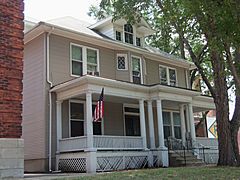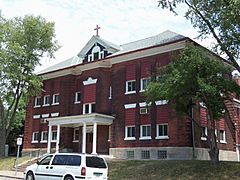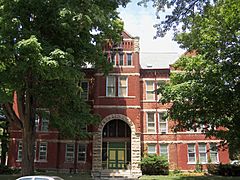St. Mary's Catholic Church (Davenport, Iowa) facts for kids
Quick facts for kids St. Mary's Catholic Church |
|
|---|---|

St. Mary's Catholic Church from Fillmore St
|
|
| Lua error in Module:Location_map at line 420: attempt to index field 'wikibase' (a nil value). | |
| Location | 516 Fillmore St. Davenport, Iowa |
| Country | USA |
| Denomination | Catholic Church |
| History | |
| Founded | July 21, 1867 |
| Founder(s) | Rev. J.A.M. Pelamourges |
| Dedication | Mary, mother of Jesus |
| Architecture | |
| Functional status | Active |
| Groundbreaking | 1867 |
| Completed | 1867 |
| Construction cost | $25,000 |
| Specifications | |
| Number of spires | One |
| Spire height | 135 feet (41 m) |
| Materials | Brick |
| Administration | |
| Diocese | Davenport |
St. Mary's Catholic Church was a special church in Davenport, Iowa, United States. It was part of the Diocese of Davenport. The church building is located in the west part of Davenport, at the corner of Fillmore and W. 6th Streets.
This church is listed on the National Register of Historic Places. This means it is an important historical site. The listing includes the church building, the rectory (where the priest lived), a former school, and a convent (where nuns lived). Another old school building, called St. Mary's Academy, is also on the National Register. St. Mary's Church stopped its regular services in July 2020. It joined with St. Anthony's Church downtown. The church campus is now used by a group called Humility Homes & Services. This group helps people who need homes.
Contents
History of St. Mary's Church
How St. Mary's Began
St. Mary's Church started in 1867. It was created for about 150 English-speaking Catholic families in Davenport's west end. Another church nearby, St. Kunigunda (later called St. Joseph), mainly served German families.
Bishop John Hennessy laid the first stone of the church on July 21, 1867. The church was built on land that was once part of St. Mary's Cemetery. This cemetery was started in 1849. The church cost $25,000 to build. Ten years later, a rectory was built for $8,000.
The first pastor was Rev. J.A.M. Pelamourgues. The first priest who lived at the church was Rev. Maurice Flavin. He arrived in May 1868. In 1881, St. Mary's became part of the new Diocese of Davenport.
Church Features and Changes
In 1883, the church got a new pipe organ. It was built by the Moline Pipe Organ Co. A church organist named Célestine Fejérvary brought a special painting to the church. It was called Assumption of the Blessed Virgin by Guido Reni. She got it in Belgium in 1893. Both the organ and the painting are still in the church today.
Around 1900, the church built a new school and a convent. These buildings were across the street from the church and rectory. They were finished in 1901. The Davenport company Clausen & Burrows designed them. The convent cost $7,000 and the school cost $19,000.
In the early 1940s, a new reredos (a screen behind the altar) was built. It included the Reni painting. On Christmas Eve in 1947, a fire damaged the church. It mainly affected the west side and the altars. Christmas services were held in the school auditorium that year.
Later, in the late 1980s, the church welcomed Davenport's Spanish-speaking community. Services were held in English, Spanish, and sometimes Latin.
A tornado hit Davenport on October 6, 2016. It caused some damage to St. Mary's Church and other buildings. Repairs were made in the summer of 2017.
Merger and New Purpose
In October 2019, Bishop Thomas Zinkula announced that St. Mary's might merge with another church. This was because fewer people were attending, and there were not enough priests or money. However, parishioners said St. Mary's finances were actually good. Attendance at Latin and Spanish Masses was growing.
After discussions, it was announced in March 2020 that St. Mary's would merge with St. Anthony's Church. This merger happened on July 1, 2020. The Latin Mass services moved to Holy Family Church.
Jubilee Center
In December 2020, Humility Homes & Services bought the church complex. This group helps people who are homeless. They plan to use the old convent as office space. The former rectory will be housing for women. The old church building will become the Fresh Start Center. Here, people setting up new homes can get items they need for free. All religious items were removed from the church. The former school building is still used for community groups, especially the Hispanic community. The whole campus is now called the Jubilee Center.
Parochial School History
St. Mary's started a school a year after the church was formed. The church building itself was the first school. Later, a bigger school building was built two blocks north of the church. The Sisters of Mercy taught at this school.
The current school building was built in 1901, right across from the church. The Sisters of the Holy Cross then took over teaching. For a while, the school was only for girls. In 1931, high school girls started going to Immaculate Conception Academy. St. Mary's continued to support its own school. Later, it merged with St. Joseph parish to form Holy Trinity school. This merger ended in the 1990s.
Architecture and Design
The four main buildings of St. Mary's complex are across the street from each other. They all look similar because they are made of dark red brick. The convent building now has vinyl siding.
The church was built in the Romanesque Revival style. This style often uses round arches and strong, simple shapes. The church has a rectangular shape. It has decorative brickwork and a tall central bell tower that is 135 feet (41 m) high. The outside walls have special brick designs called corbelling and brick pilasters. These frame the tall, narrow windows, which have round arches at the top. The top of the tower has more decorations. These include small gables with crosses, arched openings for bells, and small round windows called oculi.
The rectory was first built to match the church's style. Its look was changed around 1901 when the convent and school were built. The school and convent were designed in the Colonial Revival style. This style often looks like older American colonial buildings.
Pipe Organ
The church has a pipe organ built by the Moline Organ Co. in 1883. It has two keyboards and 18 different sounds, called stops.


